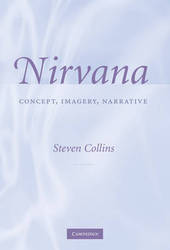
|
Nirvana: Concept, Imagery, Narrative
Hardback
Main Details
| Title |
Nirvana: Concept, Imagery, Narrative
|
| Authors and Contributors |
By (author) Steven Collins
|
| Physical Properties |
| Format:Hardback | | Pages:204 | | Dimensions(mm): Height 235,Width 158 |
|
| Category/Genre | Buddhism |
|---|
| ISBN/Barcode |
9780521881982
|
| Classifications | Dewey:294.3423 294.3423 |
|---|
| Audience | | General | | Further/Higher Education | |
|---|
|
Publishing Details |
| Publisher |
Cambridge University Press
|
| Imprint |
Cambridge University Press
|
| Publication Date |
25 March 2010 |
| Publication Country |
United Kingdom
|
Description
The idea of nirvana (Pali nibbana) is alluring but elusive for non-specialists and specialists alike. Offering his own interpretation of key texts, Steven Collins explains the idea in a new, accessible way - as a concept, as an image (metaphor), and as an element in the process of narrating both linear and cyclical time. Exploring nirvana from literary and philosophical perspectives, he argues that it has a specific role: to provide 'the sense of an ending' in both the systematic and the narrative thought of the Pali imaginaire. Translations from a number of texts, including some dealing with past and future Buddhas, enable the reader to access source material directly. This book will be essential reading for students of Buddhism, but will also have much to teach anyone concerned with Asia and its religions, or indeed anyone with an interest in the ideas of eternal life or timelessness.
Author Biography
Steven Collins is Chester D. Tripp Professor in the Humanities at the University of Chicago. He is the author of Nirvana and Other Buddhist Felicities: Imagery and Thought in Theravada Buddhism (Cambridge University Press, 1998).
Reviews'... an academically thorough and, I would dare to say, passionate exploration into a concept that invites description and evocation but is beyond both.' Buddhist Studies Review '... for those whose main interest is in appreciating or teaching Collins's creative ways of engaging with the enigmatic yet fundamental Buddhist motif of nirvana, this new presentation of his work is really just perfect.' The Journal of Religion 'The book remains an indispensable addition to courses on Buddhism.' Natalie Gummer, Religious Studies Review
|